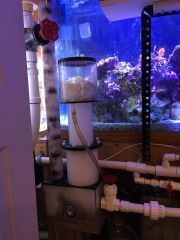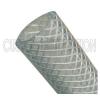-
Posts
9,004 -
Joined
-
Last visited
Content Type
Profiles
Forums
Gallery
Events
Store
Everything posted by flowerseller
-
I built this new type of skimmer 21 years ago and still use it to this day. I copied it from a picture I saw in a new, at the time, magazine called Aquarium Frontiers. It was not even in production yet but the inventors had put a pic and interview in the magazine. It still ROCKS today on my 400g system.
-
-

My DIY downdraft skimmer is now old enough to drink
flowerseller posted a gallery image in Member's Gallery
From the album: DIY
I built this new type of skimmer 21 years ago and still use it to this day. I copied it from a picture I saw in a new, at the time, magazine called Aquarium Frontiers. It was not even in production yet but the inventors had put a pic and interview in the magazine. It still ROCKS today on my 400g system. -
What's the maintenance like on the bucket head? How fast does it draw water out - how quick does it fill the 5g bucket?
-

Yellow wrasse shaking head out of water
flowerseller replied to gmerek2's topic in General Discussion
/\ humm where's the "like" button -

Yellow wrasse shaking head out of water
flowerseller replied to gmerek2's topic in General Discussion
looking for a place to jump -
Nice work!
-

How prepared are you for snowmageddon?
flowerseller replied to arking_mark's topic in General Discussion
hotel -
what are the fish inhabitants in the tank? If it now only grows on the teeth of the overflow, it sounds as though the inhabitants may now be able to keep it in check once you got it to a manageable level. Inhabs may not be able to reach the overflow teeth but can reach the rocks or other growing surfaces inside tank.
-

Is it safe to use a cat litter jug for ATO?
flowerseller replied to SandJ's topic in General Discussion
POST A PIC WHEN DONE. i GOTTA SEE THIS -
Nice job Bruce. Thanks for sharing
-
Nice job!
-
mangrove roots that are exposed are merely a function of time = age of plant. Branching is the same although thoughtful pruning at the correct time aids it. There is no hurrying this. While mud may be considered "natural", it is clearly not needed and if you have any sand sifters, it becomes quite messy. Two main pest issues for mangroves are scale and mealy bug. Scale is the worst and difficult to treat. Mealy bug not as difficult. If you keep them long enough, you will likely encounter both at one point or another. water flow in and around the roots is fine but is not mandatory. Be aware of mangroves that were rooted in fresh water - you must acclimate them to saltwater similar to hypo salinity Contrary to popular mistaken belief, mangroves are not a great source of natural filtration like an algae scrubber can be unless you have a ton.
-
sand
-
how about passing it this way? along with the lighter.
-
Sorry about that. Tell us about the fish in your tank
-
Clams can loose their foot as they get larger or even for no apparent reason. Unless it was damaged for some reason known or unknown to you, I would not sweat it unless it stops reacting or gapes some what open. I would orient it upright,wedged if needed, but so it can open un obstructed. More than likely someone may be messing with it and you have not seen it, yet.
-
I used 3 x 250w on commercial ballasts for 15 years, bulbs about 14" from water line. I used full sized lumenarc reflectors and supplemented with 2x 160w 03's. I changed bulbs 10-12 months. I used a chiller and of course UV. 2-3" white sand bed I had plenty of sps but not strictly sps at all levels.
-
I'm only talking about the "tiger flex" or "spa" hose. Not this fiber enforced stuff I have pictured below. I do not use it at all because it is often way to firm and usually requires a clamp, at least for pressure apps. If spa flex, white flexible PVC hose, is done correctly, you will not have a problem. That's probably why it's used on spas which are often under as much or more head pressure, read back pressure, than most aquarium return lines. My whole system is plumbed using 1 1/2 flex all backed up to a 3/8 hole for my DD skimmer. While there are several gated 1" branches off of it, all water is trying to go through a 3/8" hole as it's main objective.
-
I have flex pvc joints that are 15+ years old. I have always used Rain R Shine by Oatey and do not use primer because it's already part of the "blue"cement. Flex pvc will become less flexible over the years but that's fine because it's already in place. I like it because it's easy to route and it also dampens all the vibration caused by larger external pumps. Even a 6" piece of flex placed inline at the in and out of the pump will do the trick of dampening vibration noise. I believe most folks experience failure for two main reasons, use of secondary primer and not holding the joint together for a few moments when gluing. It is important to make sure you apply cement to both parts of each joint, push together completely and then hold it for a moment or two before moving on. The more joints, or sharp bend joints that you have in hard plumbing, the louder your plumbing for a drain may sound.
-
I would too. My internal set up is 17 years old. Even though it's a small internal box by comparison, I still wish from an optical view it had been different the whole time. I use 2 x2" drains that are underwater inside the box that flow out to a sloping T. I have a riser tube on the external part above the tank with a vent hole and the drains are whisper silent with 2500 PLUS gph.
-
Have they considering moving and leaving it for someone else to deal with?
-

Help -- Posting Pictures at Lower Resolution
flowerseller replied to Tnguyen's topic in General Discussion
I use http://www.photobucket.com sometimes use the link and c&p into place -
You can also use vegetable oil instead of water. Just remember you're not frying chicken here so a little dab will do ya. spread thin, wiping up any excess.
-
I also use channellocks to tighten larger bulkheads. I'm guessing Rob's suggesting he uses channellocks to EVENLY tighten them. Tightening a bulkhead with even pressure on the nut as opposed to tightening a bulkhead with a cantilever type pressure against the fitting are two different things. The latter being the real culprit in cracking tanks. (unless it's a very poorly drilled, splintered, hole to begin with) Just watch you have the plyers on the nut, not on the nut and against the flange shaft as well. = cantilever type pressure I'm also not suggesting you need to brace yourself against a fixed object to get even more pressure since you can strip or crack the nut. I also won't mention wetting the tank, gasket, and flange surfaces prior to tightening since we all do that anyway.





